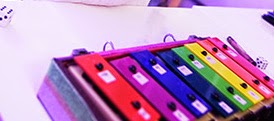Math-Hater-Mom here again, folks - trying to make some preschool love for Math so that future work won't be such a future pain. (Struggling with profit-and-loss statements takes all the fun out of my job, if you ask me)
So far I've tried-and-junked being all 'teacher' at home and decided to be a 'playmate' instead. Apparently I was such a drag before that she ended up refusing to work on numbers in school! As her math 'playmate' today there's less pressure and more fun for both of us. So I'll leave the teaching for school, but the basics of playing math at home are always Montessori-inspired:
 |
| My first post (left) about discovering and starting number sticks is here. Must read first! A second one (right) about two ways to use them with a timer is here. |
 |
| I left this play for her to do while I was at work (it's my thing). It was untouched for a week. So I reached for it one night to play together and I found out her fingers weren't strong enough yet. |
 |
| Apparently she needed two hands. This is a great way to build finger strength needed for writing. |
 |
| Now it's fun when you play! |
 |
| Counting to see who was the winner. |
 |
| Using the sticks builds number sense! |
Game 2 - Race to the Finish
We use the number sticks as the game board itself - players move by putting down number sticks until they reach the end.
For addition practice, add up the two numbers you get after throwing the dice:
 |
| For younger children, just use one die |
Here she is using the number sticks to solve the equation:
 |
| We had trouble with 'dynamic' addition (when the answer crosses over ten). When we'd get a sum of eleven or twelve, I'd try to teach but I could tell she hadn't grasped the concept yet. |
The best part of this game is that daddy gets to join in.
 |
| The tokens move along with the number sticks (just for fun) |
Game 3 - Make Me The Number
This one is a simple game that practices math sense. Montessori Math is sensory learning in itself because it makes math real through materials. It makes the concept of higher numbers a real picture of amounts in their heads. At some point, so much of math can easily become memorisation rather than real understanding, so having a good foundation helps!
Let me show the little DIY math toolbox we have in her shelves:
 |
| Print and laminate number cards from Montessori Printshop. |
We use the number cards almost every time we play with the number sticks (or when whatever we're doing can become a practice for understanding numbers past ten).
Only bring out the cards that can match the amounts of number sticks or base tens that you have. Turn the cards over and ask her to pick one from each decimal place group.
She got '5' from the units (ones) place, and '10' from the tens place. Here she is making that amount:
 |
| She's using the units this time instead of bringing out the five stick |
Now for bigger numbers. Turn it into a game by saying that whoever makes the bigger number wins!
 |
| You can compare the sizes of the piles to show that her '888' is obviously bigger than your '111'. |
***
What are some sneaky ways you play math with your little ones? Do workbooks work for you? I tried sitting her down with a workbook at home and she immediately turned listless. But at her school she's so much more game to do equations, even long ones.
I remember my math teacher teaching the concept of 'carrying one' on the blackboard and I didn't get what she was doing. I memorised the methods, and did a pretty good job at math throughout school life ... until I took an accounting class in college and flunked the damn thing. I eventually passed when I stopped memorising math methods and started understanding why I was doing what. But I developed a deep dislike of math.
That's pretty much the cycle we need to break for our kids today.
Luckily there's always play.
































